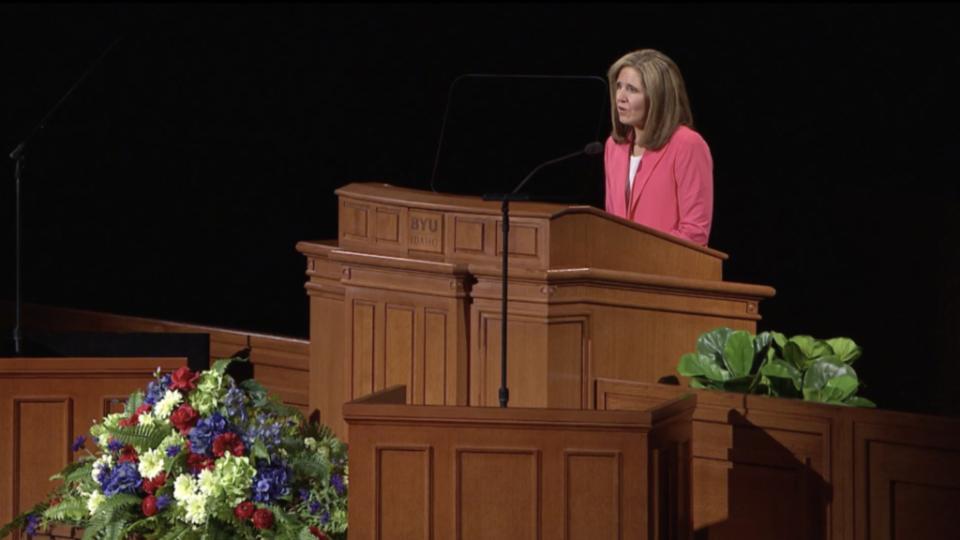| Temple Square is always beautiful in the springtime. Gardeners work to prepare the ground for General Conference. © 2012 Intellectual Reserve, Inc. All rights reserved. | 1 / 2 |
This story appears here courtesy of TheChurchNews.com. It is not for use by other media.
By Megan McKellar, Church News
Lasting change usually happens gradually, taught President Henry J. Eyring in a recent BYU–Idaho devotional, “often in a dance of two steps forward and one or more steps back.”
These “steps back” can lead to frustration and the feeling that the windows of Heaven are closed.
Earthly temptations and weaknesses can also prove to be a challenge, as demonstrated by the Apostles Peter, James and John in the Garden of Gethsemane, where they struggled to stay awake while the Savior undertook His Atonement. After finding them asleep, Christ said, “What, could ye not watch with me one hour? Watch and pray, that ye enter not into temptation: the spirit indeed is willing, but the flesh is weak” (Matthew 26:40-41).
When President Eyring was a young father, he was “frustrated in his professional ambitions (and) he let distress get the better of him.”
“And I failed to hide that distress, as was manifested in my hair, which fell out from head to toe, including eyelashes and brows,” he recalled.
He asked his wife to seek Heaven’s help on his behalf. Several days later, she returned and told him, “I have received a clear answer. I was told, ‘Henry should keep a journal.’”
Although it was not the answer he was hoping for, President Eyring found “emotional and spiritual salvation” in journaling as he began to recognize signs of hope and even small miracles in his daily activities.
“I still felt a sense of falling and failing spiritually,” he recounted. “However, the rate of falling was slower.”
The stories of Alma the Younger and Paul and their miraculous, quick conversions are the exception rather than the rule of “incremental and sometimes frustratingly slow self-improvement.”
However, it’s important to note that their spiritual conversion and gospel training didn’t end there.
“Paul seems to have spent several years in what may have been a kind of personal MTC experience in a place referred to as Arabia. Likewise, Alma and the sons of Mosiah invested much time and effort over a lifetime to cement their testimonies,” President Eyring pointed out.
Personal improvement is an incremental and often slow process that is guided and aided by the Spirit. President Eyring said, “I have learned from experience that it is hard to make big, permanent changes quickly. I also struggle to make more than one or two personal changes at a time.”

Eyrings-2.jpg
President Henry J. Eyring uses flying an airplane in a storm to demonstrate a principle during a BYU–Idaho devotional, April 20, 2021. Screenshot courtesy of Church News.All rights reserved.He illustrated this principle by using a scenario that airplane pilots encounter during turbulence.
“Let’s imagine that you and I are piloting an airplane through a storm. After brief consultation, we begin a steep descent, to get below the storm,” he said. “But, as we finally emerge from the clouds and turbulent air, we see that we’re closer to the ground than expected. The natural inclination at that point is to pull back hard on the airplane’s yoke, or steering wheel, with the hope of climbing. However, that move could lift the nose of the plane and slow it to the point of causing a stall and possibly a crash. In other words, overreacting to a downward trajectory, particularly by pulling up, could be fatal. Pilots call this ‘getting behind the power curve.’”
Something similar can happen when setting self-improvement goals. “Particularly at the end of a lackluster year and the beginning of a new year, I’ve tended to make ambitious lists of tasks and performance targets,” President Eyring said.
However, trying to change too much all at once can be counterproductive, “as the gap between my lofty ambitions and my currently limited capabilities widens.”
“An emotional ‘stall’ is almost inevitable, resulting in further drops in confidence,” he explained.
Examples of a “slow-but-steady turnaround” are provided in the scriptures and Church history, such as the prophet Enos, the prodigal son, the New Testament Apostle Peter and Joseph Smith.
Life is all about learning to “fly spiritually.” Staying ahead of the spiritual “power curve” requires Heaven’s help and one’s best efforts.
“Flying sometimes means falling below our preferred altitude and trajectory,” President Eyring taught. “When that happens, we need to lower the nose of our spiritual airplane and add power, rather than pulling back and risking a stall.”
He showed a formula that helps him apply this principle: Fewer Sins (or Drag) + More Service (or Thrust) = Greater Spiritual (or Aeronautical) Power.
“Applying this formula, we can stay ahead of the spiritual power curve, lifting others as we go and arriving safely at our spiritual destination, in the celestial kingdom with our Heavenly Father and our Savior Jesus Christ.”
As students begin a new semester, Sister Kelly Eyring offered words of encouragement and wisdom regarding learning and mastering new skills.

Eyrings-6.jpg
Sister Kelly Eyring addresses students during a BYU–Idaho devotional, April 20, 2021. Screenshot courtesy of Church News.All rights reserved.She shared video clips of her grandchildren learning to walk and making a mess while eating.
“Luckily, our Savior has paid the price for all of our messes and will welcome our efforts to clean up as much as possible,” she said. “Ultimately, though, He will come to our rescue.”
While President and Sister Eyring were serving a mission in Japan, they encountered challenges, and their old life and friends seemed far away.
“I remember thinking, ‘I hope when we go home it can all just be the way it was before,’” she recounted.
But Sister Eyring quickly realized that she did not want to trade the experiences they had enjoyed during the mission for the sameness that she thought she was longing for.
Recently, Sister Eyring has heard people say, “I can’t wait until things get back to the way they were.”
“We might say that or think that, but it is not possible, nor do we really want that,” she said. “We get to go forward, taking with us the things that we have learned.”
She invited students to learn and move forward this semester, and to do it “in a way that incorporates what we have learned this past year, and let’s be open to learning so much more.”
Copyright 2021 Deseret News Publishing Company